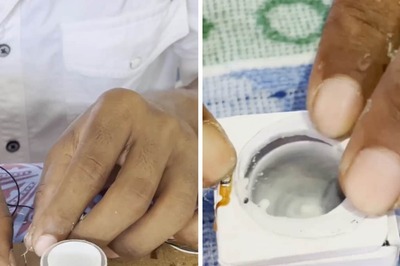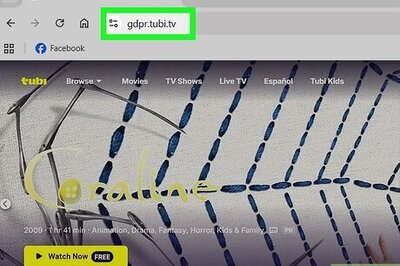
views
Rick Rashid
Age: 59
Designation: Senior Vice-President, Research, Microsoft.
Role: Has been heading Microsoft’s research division since its inception in 1991. Walks the research tightrope of defending Microsoft’s blockbuster product portfolio while creating disruptive new ones. Heads the Ph D army that is behind many of Microsoft’s new successes – XBox, Windows Phone, Bing and Kinect. Prefers the serendipity of letting smart researchers go loose, than pinning everyone down with agendas.
For the longest while, Microsoft was the ruthless, yet cool company everyone talked about. Then it became too big, too slow and too starved of meaningful competition. The coolness started evaporating, drawn first towards Google, then Apple, then any number of Internet companies like Salesforce.com or even Facebook.
But over the past few years, the company has been working quietly and hard to win back its mojo, with pretty good results. Bing, a spanking new search engine; Kinect, a controller-less game controller for the Xbox; Windows Phone, a peppy and imaginative mobile operating system that has already won rave reviews.
Rick Rashid, a soft spoken scientist, is the unlikely hero responsible for igniting a lot of sparks behind Microsoft’s latest successes. As the head of Microsoft Research, a division comprising over 850 researchers across six labs around the world, including one in Bangalore, Rashid is responsible for conducting the ‘blue sky’ research that enabled Microsoft to remain nimble in the face of changing environments and newer competitors. Excerpts from an interview:
Microsoft will spend $9.6 billion in 2011 on R&D. Where does all of that go and what percentage comes to MS Research?
That number describes all the things we do, including Windows and Office development. What comes to us is for basic research, which means investing for the future, an insurance policy for the future. We’re doing things that when we start, we don’t know if they are going to be successful. For us it’s more about ideas and taking risks.
Basic research is about agility. It’s about giving you the ability to change when you most need it. Think of it as getting into a World War. If something like that happens, then do you have the ideas and people to get you through it? If a new competitor or business model threatens you, then do you have the people and treasure chest of ideas to survive or compete? Which is why we invest in basic research.
Historically, companies that didn’t make those investments didn’t survive, like Microsoft’s peers back from 1990-91…WordPerfect, Lotus. When I joined, we just had Word, Excel and DOS; Windows was just up and coming; we didn’t even have Office and we primarily sold packaged products through retail channels. Today, we sell relatively little packaged products while the breadth of products we sell is huge, covering most areas around computing, including even games and consumer products.
When we made a decision to enter the search business, we were able to rely on the top information retrieval group in the world, allowing us to enter the space quickly and be competitive. What made Bing a big release? A lot of the technology came from Microsoft Research — instant answers [which Google has tried to quickly catch up with], using more machine intelligence, learning to understand user intent, doing a better job of recognition.
Microsoft is estimated to have spent close to $70 billion on R&D in the last 10 years. But there’s a feeling that path-breaking results from that money have been limited due to the ‘innovator’s dilemma’ — that it makes better sense to defend your existing markets than create bold new ones, some of which could possibly upend you. How do you deal with that?
How much revenue did we generate during those 10 years? Probably $ 0.5-0.75 trillion.
When we make investments in newer versions of Office or Windows, we’re dramatically changing those. Most people lose track of how many new products we have created and how they’re impacting our bottom line. Sharepoint is [a] multi-billion dollar product built over the last 10 years. With Xbox we have the lion’s share of money in the game console space.
We sold 8 million Kinects in less than two months of launching. Kinect is an interesting product because it is the first mass-market real-time 3D computer vision product. This used to be everyone’s dream when I was in college.
Much of the cutting-edge work today happens outside of company-owned labs. What are your prescriptions towards tapping those? Does open innovation figure formally as an agenda item for you?
We work closely with academia. From the beginning, for each of our labs, we have technology advisors consisting of academics that review and advise. We also make significant investments in students and universities. More than 15 percent of all the money we spend on basic research goes as research or laboratory grants, fellowships and internships.
We run the largest Ph D internship project in the world — more graduate students’ hours are spent at Microsoft Research than at any university. Over 1,000 Ph D students spend three to six months working with us around the world every year. That is a huge resource intellectually.
All of these are ways to make sure we remain intimately connected to the academic world.
How do you align long-term pure research to dovetail with MS’ product strategy?
We have a group of people doing full time technology transfers. Having worked in product teams in the past, they monitor research and keep track of products; match and connect them. They recognise opportunities and then bring people together, in many ways, like ‘personal glue’. It is one of the single most important things we do.
Technology transfer is not about technology but about building connections between people — specifically researchers and product teams.
Let’s take Kinect. The underlying research work behind that goes back to 1990s though the specific product work goes back two years. Todd Holmdahl [corporate vice president, Interactive Entertainment Business] came to me and said I want your team’s help. His people had begun to talk to our researchers, so there was already a link. They were looking for ways to handle huge variations in people’s homes, clothing and individuals; and being able to robustly connect actions of user to characters on screen.
For example, say a dog runs in front you while using Kinect. Now if all you had was skeleton information from a 3D camera, then you could lose track of the arms and legs, but Kinect can recover from those kinds of interruptions of information and create the illusion to the user that it always saw the user. It’s very similar to what you and I do — just because my arm or leg went behind a table you don’t think it disappeared.
All of this requires very sophisticated computer vision and machine learning, both of which we began investing on in the 1990s.
Windows Phone 7 has been getting rave reviews for re-imaging mobile User Interface. What MSR projects went into it?
We’ve been working with various versions of mobile, including Windows Mobile and Windows CE, since the early 1990s.
Over time, we’ve added more intelligence about what you’re doing. As you’re doing your email, as you begin to type, we try to guess who you’ve been talking to, or what words you’re typing, what keys you’re typing. The idea is to use more intelligence so [the] user has to do less.
The word recogniser in our Bing search engine effectively does machine translation and learning algorithms, translating what people type to what they probably meant.
Innovation will often lead to failure. How do you deal with it?
We don’t deal with it.
You want silent failure, don’t make a big deal of it and let people move on. If you punish failure, you will reduce risk taking. The biggest asset for research is risk taking; ultimately you’re not going to get value if that goes down.
The biggest mistake people make when they try to manage research is they ‘manage’ research. You can only manage researchers.
When it comes to pure research, how do you know when to pull the plug on something?
It’s not about managing ideas but people. A good researcher will figure out and self correct, or the community itself will self correct. I don’t need to do that. There are times if someone gets stuck and bangs their head against the wall, then there are management techniques to get them to move on.
For instance you say “Have you talked to so-and-so?”
Hiring and firing are the two most important things I do. Most people mismanage research by trying to pick and choose winners and losers.
We never try to predict what will show up in a product till we’ve announced a product.
For instance, we still don’t know where quantum computing is going even though people have been working on it for over 15 years. Yet we’ve got some good ideas on that too through a research group in Santa Barbara that is working with physicists. It’s one of those ideas that could never turn into anything or suddenly become the best — you won’t know till you get there.
It’s easy to dismiss something because it hasn’t happened yet, but technology to make it happen could be right around the corner because of investments made. Who knows, when it happens next, it could create a new billion dollar product.



















Comments
0 comment